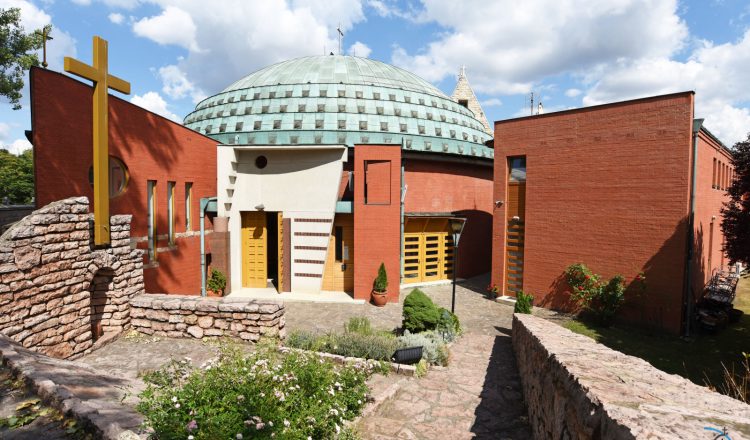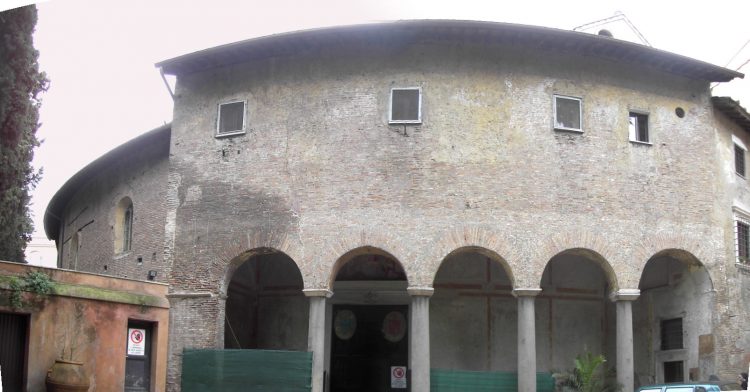
The Church of the Hungarian Saints: a spiritual centre for the youth

The Church of the Hungarian Saints, being amongst the newest religious buildings in the capital city of Hungary, is located right next to the Campus of the Eötvös Loránd Public University.
There was once a plan…
This area of the city was expected to serve as the site of the 1996 EXPO. As to the original plans the building complex was aimed to be the Vatican Pavilion of the Budapest EXPO, and to become a parish church afterwards.
Papal blessing
Although the world event was cancelled by the then government, the Archdiocese took over the church construction duties. The church would have been consecrated by Saint Pope John Paul II on the fifth anniversary of his first visit to Hungary, but this plan could not materialise. Since the Polish origin Holy Father had deep bounds to the Church of the Hungarian Saints, on September 7, 1996 on the second day of his two days visit to Hungary, at the Holy Mass in Győr, the Head of the Catholic Church blessed the very marble slab that was finally placed in the new church.
From the first hoeing to the consecration
The cornerstone was laid down in May 1995, while the first Holy Mass was held on November 13 the same year and celebrated by Vicar General, Antal Spányi. This date has also become the festive day of the newly built church, coinciding with the feast day of the Hungarian Saints, so has been named accordingly. Eventually the church was consecrated on August 17, 1996 by Cardinal László Paskai, and received parish church status on January 1, 2001.
Seeding
Given the University Campus is just a stone’s throw from the parish church, it has become obvious that the church should also serve as home to the University Chaplaincy of the Roman Catholic Church. Following the regime change, the youth’s spiritual care first restarted in the Piarist Chapel, located at the Order’s recently returned building at the Pesti Barnabás street. Later on this newly constructed complex, the Church of the Hungarian Saints took over the ministry of the University Chaplaincy that currently includes lectures for the community and to the public, organisation of the club life and excursions for the youth, all in all it plays an important role and is present in the university life. The Chaplaincy community turned out to be a veritable seedbed in the cooperation between the historical Christian Churches, and in a short time the Christian Ecumenical Student Movement has been formed.

Unusual architectural church shape
The church building is far from being an ordinary one. There are no conventional church elements such as a sky climbing bell tower. The architect was inspired by the early Christian Rotunda in Rome (“Santo Stefano Rotondo”, the Basilica of Saint Stephen in the Round) that dates back to the 5th century A.D. and is named for Stephen, the first Christian Martyr, and which is now Hungary’s “national church” in the Eternal City. The sibling of the Rome’s Rotunda is also a centrally planned church, with an inner circular shape that is surrounded by an external ring. The church can be accessed through a two-story gate, leading us first into a courtyard complex, and only from here open the church entrances. These “adherent” structures, like a “city wall” hide the slowly unfolding beauty of the central space. The complex interior-exterior space structure gives a character of ever varied beauties that are slowly showing themselves over the time.
Donation
The sacristy gives home to the copy of the Blessed Virgin of Guadalupe relic, while the statue “Madonna of Csurgó” , an Amerigo Tot’s artpiece can be seen in the church interior. The statue is Tibor Benedetti’s construction supervisor’s donation to the church in commemoration of his deceased relative.
Curiosity in the sanctuary
The sanctuary is embellished by a unique crucifix. The mystery of the sacrifice is framed by the unity of three materials, namely the gold, wood, and stone. The genuine gold background symbolises the heavenly smoothness, the untouchability and the divine perfection topped with eternity. The wood of the corpus also wears the wounds, while remains a living material even in its death, as the fate has been fulfilled. The Mediterranean stone block hides millions of fossils, symbolizing the earthly world, the Golgotha, and the human community that accepts and elevates the sacrifice of the cross. The Cross is the joint work of sculptor László Somogyi-Soma, painter Mihály Balázs and architect Katalin Somogyi-Soma. The IEC Mission Cross preserves the relics of Hungarian Saints, such as the church’s small chapel, just next door to the main entrance and also gives home to the relics of the canonized and beatified figures of the country.
The parish church in Lágymányos, Budapest is going to host the Holy Mass, to be held on September 8, 2021, at 17.00. The service will be celebrated by Charles G. Palmer-Buckle, Metropolitan Archbishop of Cape Coast in Ghana.
Let’s get familiar with the exceptional pastoral mission of our guest.
Have a look at the programs of the Congress, register yourself and attend the events.
The Hungarian Catholic community has been waiting eighty-three years for such a series of ceremonies, which now you can be a part of. Don’t miss the opportunity!
Source and photos: esztergomi-ersekseg.hu, magyarszentektemploma.hu










